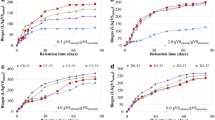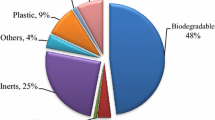Abstract
In this study, biogas yields and methane contents of vegetable wastes from Thailand’s largest agricultural market were investigated. Granular sludge from an up-flow anaerobic sludge blanket (UASB) reactor was used as inoculum. To determine the influences of the feedstock to inoculum (F/I) ratio and alkalinity, batch experiments were conducted at three different F/I ratios (i.e., 0.5, 1.0, and 2.0 g VSfeedstock/g VSinoculum), and five NaHCO3 concentrations (i.e., 0, 300, 500, 600, and 900 mg/g VSadded). The reuse of digestate from previous anaerobic reactors, as sources of alkalinity and inoculum, was also investigated. After 53 days of the experiment, without adding NaHCO3, an F/I of 0.5 gave the highest biogas yield of 851 mL/g VS and a CH4 content of 52.3%. Adding external alkalinity significantly helped to improve the biogas production and methane contents at F/I ratios of 1.0 and 2.0. The results from using the recycled digestate as inoculum were comparable with reactors using UASB sludge and helped to decrease the amount of NaHCO3 to 150 mg/g VS. The high anaerobic digestion performance in the study demonstrated the potential of utilizing the organic waste from a vegetable market as a renewable energy source.






Similar content being viewed by others
References
Johnson GI, Weinberger K, Wu M-H (2008) The Vegetable Industry in Tropical Asia: Thailand. An Overview of Production and Trade, The World Vegetable Center
Tongkhao K, Mahakarnchanakul W (2014) Country report on fruit and vegetables consumption in Thailand. In: Workshop on improving safety of fresh agricultural produce from farm to table in Asia. Food and Fertilizer Technology Center, Philippines, pp 38–42
Bouallagui H, Touhami Y, Cheikh RB, Hamdi M (2005) Bioreactor performance in anaerobic digestion of fruit and vegetable wastes. Process Biochem 40:989–995
Panyaping K, Moontee P (2018) Potential of biogas production from mixed leaf and food waste in anaerobic reactors. J Mater Cycles Waste Manag 20:723–737
IRENA (2017) Renewable Energy Outlook: Thailand. International Renewable Energy Agency, Abu Dhabi
Chaiprasert P (2011) Biogas production from agricultural wastes in Thailand. J Sustain Energy Environ Spec Issue 2011:63–65
Kothari R, Pandey A, Kumar S, Tyagi V, Tyagi S (2014) Different aspects of dry anaerobic digestion for bio-energy: an overview. Renew Sust Energ Rev 39:174–195
Ward AJ, Hobbs PJ, Holliman PJ, Jones DL (2008) Optimisation of the anaerobic digestion of agricultural resources. Bioresour Technol 99:7928–7940
Siegert I, Banks C (2005) The effect of volatile fatty acid additions on the anaerobic digestion of cellulose and glucose in batch reactors. Process Biochem 40:3412–3418
Chen Y, Cheng JJ, Creamer KS (2008) Inhibition of anaerobic digestion process: a review. Bioresour Technol 99:4044–4064
Appels L, Baeyens J, Degrève J, Dewil R (2008) Principles and potential of the anaerobic digestion of waste-activated sludge. Prog Energy Combust Sci 34:755–781
Monson K, Esteves S, Guwy A, Dinsdale R (2007) Anaerobic digestion of biodegradable municipal wastes: a review. University of Glamorgan ISBN 2007:978-971
Guwy A, Hawkes F, Wilcox S, Hawkes D (1997) Neural network and on-off control of bicarbonate alkalinity in a fluidised-bed anaerobic digester. Water Res 31:2019–2025
Gunaseelan VN (1995) Effect of inoculum/substrate ratio and pretreatments on methane yield from Parthenium. Biomass Bioenergy 8:39–44
Al Mamun MR, Torii S (2017) Comparison effect of feedstock to inoculum ratios on biogas yields of cafeteria, vegetable, fruit wastes with cattle manure using co-digestion process. Int J Green Energ 14:665–673
Liu G, Zhang R, El-Mashad HM, Dong R (2009) Effect of feed to inoculum ratios on biogas yields of food and green wastes. Bioresour Technol 100:5103–5108
Prashanth S, Kumar P, Mehrotra I (2006) Anaerobic degradability: effect of particulate COD. J Environ Eng 132:488–496
Ali Shah F, Mahmood Q, Maroof Shah M, Pervez A, Ahmad Asad S (2014) Microbial ecology of anaerobic digesters: the key players of anaerobiosis. Sci World J 2014:1–21
Lesteur M, Bellon-Maurel V, Gonzalez C, Latrille E, Roger J, Junqua G, Steyer J (2010) Alternative methods for determining anaerobic biodegradability: a review. Process Biochem 45:431–440
Eskicioglu C, Ghorbani M (2011) Effect of inoculum/substrate ratio on mesophilic anaerobic digestion of bioethanol plant whole stillage in batch mode. Process Biochem 46:1682–1687
Schmidt JE, Ahring BK (1996) Granular sludge formation in upflow anaerobic sludge blanket (UASB) reactors. Biotechnol Bioeng 49:229–246
Nielfa A, Cano R, Fdz-Polanco M (2015) Theoretical methane production generated by the co-digestion of organic fraction municipal solid waste and biological sludge. Biotechnol Rep 5:14–21
Cho JK, Park SC, Chang HN (1995) Biochemical methane potential and solid state anaerobic digestion of Korean food wastes. Bioresour Technol 52:245–253
Ali G, Nitivattananon V, Abbas S, Sabir M (2012) Green waste to biogas: renewable energy possibilities for Thailand's green markets. Renew Sust Energ Rev 16:5423–5429
Owen W, Stuckey D, Healy J, Young L, Mccarty P (1979) Bioassay for monitoring biochemical methane potential and anaerobic toxicity. Water Res 13:485–492
Hansen TL, Schmidt JE, Angelidaki I, Marca E, La Cour Jansen J, Mosbæk H, Christensen TH (2004) Method for determination of methane potentials of solid organic waste. Waste Manag 24:393–400
Esposito G, Frunzo L, Liotta F, Panico A, Pirozzi F (2012) Bio-methane potential tests to measure the biogas production from the digestion and co-digestion of complex organic substrates. Open Environ Eng J 5:1–8
Richards BK, Cummings RJ, White TE, Jewell WJ (1991) Methods for kinetic analysis of methane fermentation in high solids biomass digesters. Biomass Bioenergy 1:65–73
Zickefoose C, Hayes RBJ (1976) Anaerobic sludge digestion: operations manual In: Office of water program operations. Environmental Protection Agency, USA
Callaghan F, Wase D, Thayanithy K, Forster C (2002) Continuous co-digestion of cattle slurry with fruit and vegetable wastes and chicken manure. Biomass Bioenergy 22:71–77
Raposo F, Banks C, Siegert I, Heaven S, Borja R (2006) Influence of inoculum to substrate ratio on the biochemical methane potential of maize in batch tests. Process Biochem 41:1444–1450
Rajagopal R, Massé DI, Singh G (2013) A critical review on inhibition of anaerobic digestion process by excess ammonia. Bioresour Technol 143:632–641
Gunaseelan VN (2004) Biochemical methane potential of fruits and vegetable solid waste feedstocks. Biomass Bioenergy 26:389–399
Labatut RA, Angenent LT, Scott NR (2011) Biochemical methane potential and biodegradability of complex organic substrates. Bioresour Technol 102:2255–2264
Bouallagui H, Ben Cheikh R, Marouani L, Hamdi M (2001) Fermentation methanique des dechets solides en batch. In: Les Premières Journées Scientifiques de Biotechnologie. Association Tunisienne de biotechnologie, Hammam Sousse, pp 9–10
Buffiere P, Loisel D, Bernet N, Delgenes J (2006) Towards new indicators for the prediction of solid waste anaerobic digestion properties. Wat Sci Tec 53:233–241
Chen S, Zhang J, Wang X (2015) Effects of alkalinity sources on the stability of anaerobic digestion from food waste. Waste Manag Res 33:1033–1040
Rajeshwari K, Panth D, Lata K, Kishore V (1998) Studies on biomethanation of vegetable market waste. In: Biogas forum. p 4–12
Acknowledgements
The graduate scholarship provided to the first author by the Joint Graduate School of Energy and Environment (JGSEE) and the support by the Science and Technology Post Graduate Education and Research Development Office (PERDO), Thailand, are acknowledged. This study was also partially supported by Thammasat University, Thailand [contract number 2/26/2560].
Author information
Authors and Affiliations
Corresponding author
Additional information
Publisher's Note
Springer Nature remains neutral with regard to jurisdictional claims in published maps and institutional affiliations.
Rights and permissions
About this article
Cite this article
Ta, A.T., Babel, S. Utilization of green waste from vegetable market for biomethane production: influences of feedstock to inoculum ratios and alkalinity. J Mater Cycles Waste Manag 21, 1391–1401 (2019). https://doi.org/10.1007/s10163-019-00898-2
Received:
Accepted:
Published:
Issue Date:
DOI: https://doi.org/10.1007/s10163-019-00898-2




